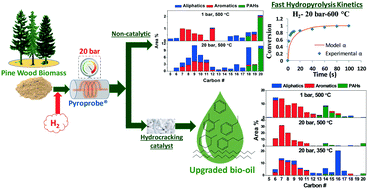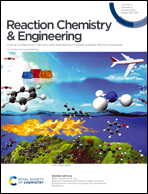Evaluation of pressure and temperature effects on hydropyrolysis of pine sawdust: pyrolysate composition and kinetics studies†
Abstract
Hydropyrolysis is a vital step in IH2® technology for the production of fungible drop-in biofuels from biomass and waste feedstocks. Hydrogen at high pressures in fast hydropyrolysis aids in improving the H/C ratio of bio-oil through deoxygenation pathways such as dehydration, decarboxylation and decarbonylation. The main objectives of this study are to understand the composition of organics and the time evolution of various functional groups during fast hydropyrolysis of pine sawdust at different temperatures, pressures, and in the presence of a catalyst. Analytical fast pyrolysis experiments were conducted in a Pyroprobe® reactor interfaced with a gas chromatograph/mass spectrometer (GC/MS) and Fourier transform infrared (FTIR) spectrometer. At high hydrogen partial pressures (10 and 20 bar), significant production of hydrocarbons, in contrast to undesirable oxygen-containing compounds at low pressures, was observed. Moreover, it resulted in a minor increase in the yield of pyrolysates and char, while the yields of pyrolysates and char increased and decreased, respectively, as the temperature was increased at high hydrogen partial pressures. The overall yield of condensable pyrolysates from hydropyrolysis was notably higher as compared to that from pyrolysis in inert atmosphere. The use of a stainless steel catalyst tube in the Pyroprobe® improved the formation of hydrocarbons as compared to that of a quartz tube at high pressures. Upgradation of pyrolysis vapors evolved from hydropyrolysis of pine sawdust at 500 °C and 20 bar over the catalyst bed maintained at 500 °C resulted in selective production of aromatic hydrocarbons (12% C6, 32% C7, 20% C8, 9% C9, 7% C10, and 4% C11). The isothermal mass loss data at short residence times were obtained using the analytical Pyroprobe®, and the apparent rate constants were determined using a 3D-diffusion model. Pyrolysis-FTIR data substantiate the significant increase in methane production with the increase in pressure. Pyrolysate composition data from Py-FTIR and Py-GC/MS techniques at various pressures were assimilated to develop a reaction scheme to describe non-catalytic and catalytic hydropyrolysis of biomass.



 Please wait while we load your content...
Please wait while we load your content...